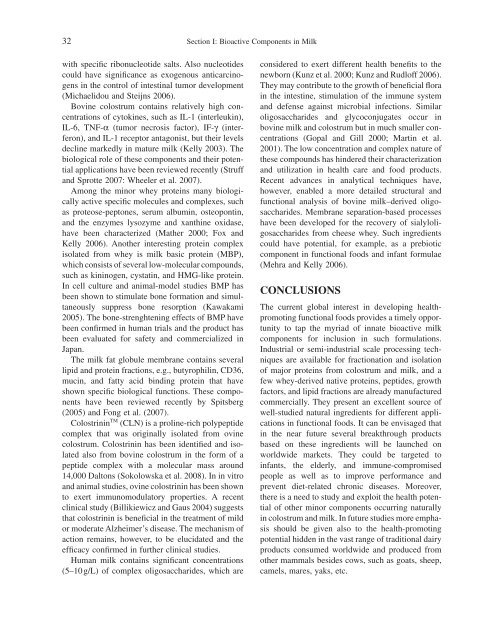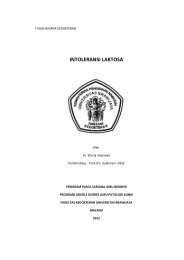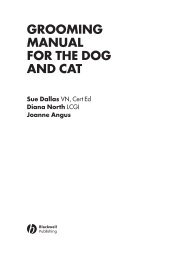Bioactive Components in Milk and Dairy Products - Prof. Dr. Aulanni ...
Bioactive Components in Milk and Dairy Products - Prof. Dr. Aulanni ...
Bioactive Components in Milk and Dairy Products - Prof. Dr. Aulanni ...
You also want an ePaper? Increase the reach of your titles
YUMPU automatically turns print PDFs into web optimized ePapers that Google loves.
32 Section I: <strong>Bioactive</strong> <strong>Components</strong> <strong>in</strong> <strong>Milk</strong><br />
with specifi c ribonucleotide salts. Also nucleotides<br />
could have signifi cance as exogenous anticarc<strong>in</strong>ogens<br />
<strong>in</strong> the control of <strong>in</strong>test<strong>in</strong>al tumor development<br />
(Michaelidou <strong>and</strong> Steijns 2006 ).<br />
Bov<strong>in</strong>e colostrum conta<strong>in</strong>s relatively high concentrations<br />
of cytok<strong>in</strong>es, such as IL - 1 (<strong>in</strong>terleuk<strong>in</strong>),<br />
IL - 6, TNF - α (tumor necrosis factor), IF - γ (<strong>in</strong>terferon),<br />
<strong>and</strong> IL - 1 receptor antagonist, but their levels<br />
decl<strong>in</strong>e markedly <strong>in</strong> mature milk (Kelly 2003 ). The<br />
biological role of these components <strong>and</strong> their potential<br />
applications have been reviewed recently (Struff<br />
<strong>and</strong> Sprotte 2007 : Wheeler et al. 2007 ).<br />
Among the m<strong>in</strong>or whey prote<strong>in</strong>s many biologically<br />
active specifi c molecules <strong>and</strong> complexes, such<br />
as proteose - peptones, serum album<strong>in</strong>, osteopont<strong>in</strong>,<br />
<strong>and</strong> the enzymes lysozyme <strong>and</strong> xanth<strong>in</strong>e oxidase,<br />
have been characterized (Mather 2000 ; Fox <strong>and</strong><br />
Kelly 2006 ). Another <strong>in</strong>terest<strong>in</strong>g prote<strong>in</strong> complex<br />
isolated from whey is milk basic prote<strong>in</strong> (MBP),<br />
which consists of several low - molecular compounds,<br />
such as k<strong>in</strong><strong>in</strong>ogen, cystat<strong>in</strong>, <strong>and</strong> HMG - like prote<strong>in</strong>.<br />
In cell culture <strong>and</strong> animal - model studies BMP has<br />
been shown to stimulate bone formation <strong>and</strong> simultaneously<br />
suppress bone resorption (Kawakami<br />
2005 ). The bone - strenghten<strong>in</strong>g effects of BMP have<br />
been confi rmed <strong>in</strong> human trials <strong>and</strong> the product has<br />
been evaluated for safety <strong>and</strong> commercialized <strong>in</strong><br />
Japan.<br />
The milk fat globule membrane conta<strong>in</strong>s several<br />
lipid <strong>and</strong> prote<strong>in</strong> fractions, e.g., butyrophil<strong>in</strong>, CD36,<br />
muc<strong>in</strong>, <strong>and</strong> fatty acid b<strong>in</strong>d<strong>in</strong>g prote<strong>in</strong> that have<br />
shown specifi c biological functions. These components<br />
have been reviewed recently by Spitsberg<br />
(2005) <strong>and</strong> Fong et al. (2007) .<br />
Colostr<strong>in</strong><strong>in</strong> TM (CLN) is a prol<strong>in</strong>e - rich polypeptide<br />
complex that was orig<strong>in</strong>ally isolated from ov<strong>in</strong>e<br />
colostrum. Colostr<strong>in</strong><strong>in</strong> has been identifi ed <strong>and</strong> isolated<br />
also from bov<strong>in</strong>e colostrum <strong>in</strong> the form of a<br />
peptide complex with a molecular mass around<br />
14,000 Daltons (Sokolowska et al. 2008 ). In <strong>in</strong> vitro<br />
<strong>and</strong> animal studies, ov<strong>in</strong>e colostr<strong>in</strong><strong>in</strong> has been shown<br />
to exert immunomodulatory properties. A recent<br />
cl<strong>in</strong>ical study (Billikiewicz <strong>and</strong> Gaus 2004 ) suggests<br />
that colostr<strong>in</strong><strong>in</strong> is benefi cial <strong>in</strong> the treatment of mild<br />
or moderate Alzheimer ’ s disease. The mechanism of<br />
action rema<strong>in</strong>s, however, to be elucidated <strong>and</strong> the<br />
effi cacy confi rmed <strong>in</strong> further cl<strong>in</strong>ical studies.<br />
Human milk conta<strong>in</strong>s signifi cant concentrations<br />
(5 – 10 g/L) of complex oligosaccharides, which are<br />
considered to exert different health benefi ts to the<br />
newborn (Kunz et al. 2000 ; Kunz <strong>and</strong> Rudloff 2006 ).<br />
They may contribute to the growth of benefi cial fl ora<br />
<strong>in</strong> the <strong>in</strong>test<strong>in</strong>e, stimulation of the immune system<br />
<strong>and</strong> defense aga<strong>in</strong>st microbial <strong>in</strong>fections. Similar<br />
oligosaccharides <strong>and</strong> glycoconjugates occur <strong>in</strong><br />
bov<strong>in</strong>e milk <strong>and</strong> colostrum but <strong>in</strong> much smaller concentrations<br />
(Gopal <strong>and</strong> Gill 2000 ; Mart<strong>in</strong> et al.<br />
2001 ). The low concentration <strong>and</strong> complex nature of<br />
these compounds has h<strong>in</strong>dered their characterization<br />
<strong>and</strong> utilization <strong>in</strong> health care <strong>and</strong> food products.<br />
Recent advances <strong>in</strong> analytical techniques have,<br />
however, enabled a more detailed structural <strong>and</strong><br />
functional analysis of bov<strong>in</strong>e milk – derived oligosaccharides.<br />
Membrane separation - based processes<br />
have been developed for the recovery of sialyloligosaccharides<br />
from cheese whey. Such <strong>in</strong>gredients<br />
could have potential, for example, as a prebiotic<br />
component <strong>in</strong> functional foods <strong>and</strong> <strong>in</strong>fant formulae<br />
(Mehra <strong>and</strong> Kelly 2006 ).<br />
CONCLUSIONS<br />
The current global <strong>in</strong>terest <strong>in</strong> develop<strong>in</strong>g health -<br />
promot<strong>in</strong>g functional foods provides a timely opportunity<br />
to tap the myriad of <strong>in</strong>nate bioactive milk<br />
components for <strong>in</strong>clusion <strong>in</strong> such formulations.<br />
Industrial or semi - <strong>in</strong>dustrial scale process<strong>in</strong>g techniques<br />
are available for fractionation <strong>and</strong> isolation<br />
of major prote<strong>in</strong>s from colostrum <strong>and</strong> milk, <strong>and</strong> a<br />
few whey - derived native prote<strong>in</strong>s, peptides, growth<br />
factors, <strong>and</strong> lipid fractions are already manufactured<br />
commercially. They present an excellent source of<br />
well - studied natural <strong>in</strong>gredients for different applications<br />
<strong>in</strong> functional foods. It can be envisaged that<br />
<strong>in</strong> the near future several breakthrough products<br />
based on these <strong>in</strong>gredients will be launched on<br />
worldwide markets. They could be targeted to<br />
<strong>in</strong>fants, the elderly, <strong>and</strong> immune - compromised<br />
people as well as to improve performance <strong>and</strong><br />
prevent diet - related chronic diseases. Moreover,<br />
there is a need to study <strong>and</strong> exploit the health potential<br />
of other m<strong>in</strong>or components occurr<strong>in</strong>g naturally<br />
<strong>in</strong> colostrum <strong>and</strong> milk. In future studies more emphasis<br />
should be given also to the health - promot<strong>in</strong>g<br />
potential hidden <strong>in</strong> the vast range of traditional dairy<br />
products consumed worldwide <strong>and</strong> produced from<br />
other mammals besides cows, such as goats, sheep,<br />
camels, mares, yaks, etc.





